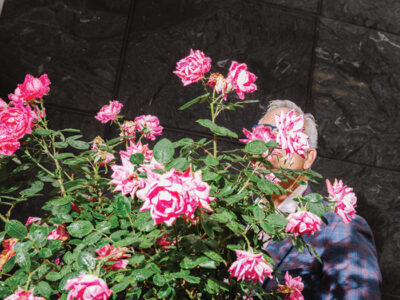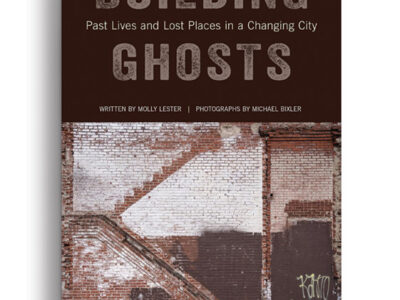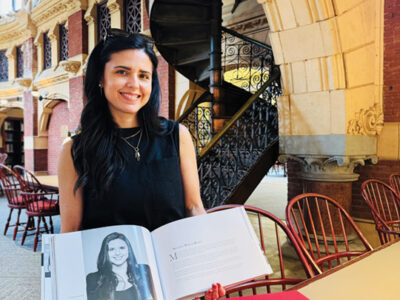A son’s study of a brilliant architect and errant father.
By Witold Rybczynski
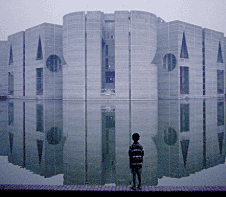
MY ARCHITECT
Written and directed by Nathaniel Kahn, Distributed by New Yorker Films
Contrary to what you might expect, film does not do well at capturing buildings, for architecture affects the entire body, not just the vision. A vast, cold, dark, echoing space like a Gothic nave is sensed as much as seen. The experience of architecture involves movement, time, memory, and scale, which are poorly simulated by the impatient, blinkered eye of the movie camera.
Perhaps the success of My Architect lies in the fact that it is not primarily a film about buildings. It recounts the poignant search of the filmmaker, Nathaniel Kahn, for his father, Louis I. Kahn Ar’24 Hon’71. Kahn, a famous architect, remained an elusive figure to his son. He was not married to Nathaniel’s mother, and he saw his son only rarely. In fact, Kahn had not only a wife and daughter of long-standing, but also another child by an earlier liaison. The three families were aware of each other, but the half-sisters and -brother met for the first time only at Kahn’s funeral in 1974, when Nathaniel was 11. At one point in the film, the architect Robert A. M. Stern warns Nathaniel not to put Louis Kahn on a pedestal. There seems to be little danger of that. The filmmaker’s struggle to resolve his conflicted feelings about his father lies at the heart of this moving story.
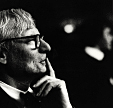
Nathaniel Kahn, who is on-camera and narrates, talks to many people about his father: relatives, friends, employees, acquaintances. Some of the most poignant scenes occur when he presses his mother on her relationship with Kahn. He also interviews several well-known architects. There is usually nothing more deadly than architects explaining architecture, a mixture of professional jargon and salesmanship. But the experienced filmmaker skillfully draws out penetrating observations. Moshe Safdie talks movingly about Kahn’s Jewishness. Philip Johnson is cheerfully self-deprecating. I. M. Pei, who is looking more and more like a wizened mandarin, is particularly insightful. Pei beat out Kahn for the East Wing of the National Gallery in Washington, but when Nathaniel alludes to the fact that his father built relatively few buildings, Pei, who has built a great many, reminds him, with what seems to be a rueful smile, that quality, not quantity, is what counts in the end.
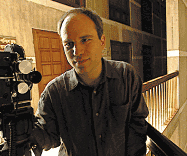
Louis Kahn’s own pronouncements about architecture could be maddeningly obscure. His students and acolytes repeated and embroidered his sayings, in an attempt to elevate the builder to the status of philosopher-cum-secular-saint. There is some of this in My Architect. The historian Vincent Scully talks cryptically about Kahn’s work in terms of the Messiah, though he charmingly admits that he knows little about Jewish religion. The Indian architect B. V. Doshi, who assisted Kahn on the Indian Institute of Management complex in Ahmedabad, refers to him as a yogi, a holy man. But the film’s most penetrating insights into Louis Kahn are more mundane. “He was really tough,” says one Philadelphia architect who worked for him. My Architect reveals Kahn to have been a man of immense and unyielding will, a will that frequently ran afoul of clients and left a wake of troubled personal relationships, but which also changed the course of modern architecture.
Louis Kahn himself is an active presence in My Architect, thanks to surviving film footage. A small man, he walks jauntily up Walnut Street, from his Center City office to his classes at Penn, which was a central presence in his life. A gifted child, both musically and in drawing, he won a scholarship to study architecture at the University. He later returned the favor by teaching here for 14 years, holding the Paul Philippe Cret Chair in Architecture. A few years before he died, the University awarded him an honorary doctorate.
But building commissions are what architects seek. In 1957 the University gave Kahn the great opportunity to build his first notable building, the Alfred Newton Richards Medical Building. The building made Kahn’s reputation but was not a functional success, and there were no more Penn commissions, even when it came time to build a new home for the Graduate School of Fine Arts (now School of Design), where Kahn taught. It is said that he refused to enter the new Meyerson Hall.
Two large Philadelphia commissions, the Mikveh Israel Synagogue and the Philadelphia College of Art, were unbuilt, so the Richards building remains the only major Kahn work in the city in which he spent almost his entire life. In the late fifties, Kahn was a consultant to the Philadelphia Planning Commission, but none of his proposals (though they entered the lexicon of urban design) were ever realized. Asked about this in the film, Edmund Bacon Hon’84, then the commission’s executive director, vehemently denounces the architect’s vision. Nathaniel Kahn is generous enough in the interview not to ask Bacon about his own pallid accomplishments at Penn Center and Independence Mall.
Philadelphia influenced Kahn—he fell in love with brick—but he was really a global architect. Nathaniel’s patient search for his father takes him to Connecticut, California, Texas, Israel, India, and Bangladesh. The capital complex in Dhaka, which includes the mammoth Assembly building, was Kahn’s largest project, on which he was working when he died. It forms the closing episode of the film. While the distant locale makes a neat ending to Nathaniel Kahn’s quest, this brooding, portentous building merely reinforces the mystical and enigmatic image of Louis Kahn that has for so long befuddled his memory. I much prefer an earlier scene: Nathaniel cheekily rollerblading on the empty travertine plaza of the Salk Institute in La Jolla, California. The looping curves of the skating son both undermine and lovingly celebrate the chaste and ordered architecture of the errant father. A wonderful film.
Witold Rybczynski is the Margy and Martin Meyerson Professor of Urbanism.


